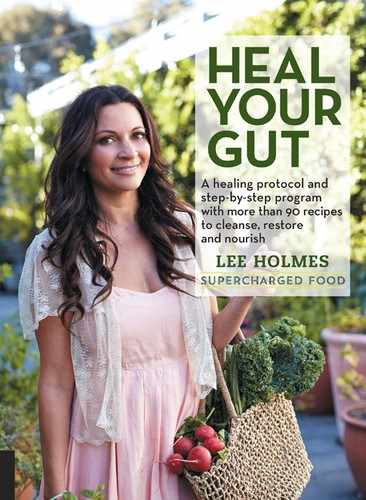PHASE ONE
THE ELEMENTAL DIET
GUT-HEALING PROTOCOL
To heal your gut to a healthy state, you’ll need to undertake an elemental (liquid) diet for four weeks. This is what I did to heal my gut and it was the absolute key to my healing. When I talk about a liquid diet I don’t mean a juice cleanse or a fad diet, I mean nutritious, easily digestible meals that your body will be able to absorb. This four-week protocol involves consuming liquid meals that still taste great but don’t lack nutrients or satiety, and are easier on the digestive system. There was a lot of trial and error involved at the time, but after much research, experimentation and speaking with integrative doctors and nutritionists, I came up with the optimum way to heal and transform my gut naturally so that my body could in turn heal and my immune system could strengthen itself. After giving my body a four-week break from digesting solid food, it was amazing how my gut lining healed and became less inflamed. This in turn enabled me to absorb more nutrients, which gave me an increase in energy and a decrease in symptoms.
FOODS TO AVOID
The first and most obvious thing I did was avoid all the foods and lifestyle factors that damage the gut and promote the growth of harmful bacteria and yeasts. These are described in more detail in “Factors that damage the gut” in Part One.
I also avoided foods that feed bad bacteria and yeasts during this period, as well as foods that continued to inflame my gut. These foods may be different for each individual, so it’s important to go on an elimination diet if a particular food is bothering you, even if it’s a healthy food, and see if your symptoms improve. Keep a food diary to manage and revisit your observations. The aim is to give your digestive tract a well-needed rest from hard-to-digest foods and foods that cause inflammation and irritation.
For me, those foods included:
* any sweetener, sugar or fruit that contains fructose. This includes honey, agave syrup, maple syrup, refined and unrefined sugar and all fruits except lemons and limes. If you need to satisfy a craving for fruit, the best ones to consume are berries, which cause the smallest number of problems. If they’re a problem for you and you see an increase in symptoms, it’s better to avoid them altogether for four weeks and reintroduce them after your gut has healed and your symptoms have reduced.
* starchy vegetables, including beets, carrots, parsnips, potatoes, squash, sweet potatoes and yams. Cut these out for the first four weeks, then reintroduce them at your own pace.
* dairy and milk products in all forms, including goat’s and sheep’s milk products. Butter can be included if it doesn’t cause symptoms. You can reintroduce goat’s and sheep’s milk products after the initial four-week period, depending upon how you feel.
* nuts and seeds, but nut milks are okay if they don’t give you any symptoms. You can warm up nut milk to create beautiful healing and nourishing warm drinks. Try the Anti-inflammatory Toddy.
* all grains, including rice, corn, millet, buckwheat, quinoa, wheat, couscous, amaranth, kamut, spelt, rye and barley. Once your gut is healed and depending upon your own preference, you can reintroduce grains that have been prepared through such methods as soaking, sprouting and fermenting. By using these preparation methods you’re helping the process of breaking down the anti-nutrients (substances that prevent you absorbing nutrients) such as phytic acid, so that the grains become more digestible.
* hard-to-digest beans and lentils, which only put strain on your digestive system at this point. They can be eaten at a later time if sprouted and soaked, preferably overnight or for at least eight hours.
* caffeinated drinks, including coffee and chocolate-based drinks. Remove the buzz and alleviate the demands it places on your overtaxed adrenal glands. Caffeine also fools your fatigue factor, and diminishes healing and detoxification efforts.
* bad fats. The most damaging fats and oils for the body are man-made hydrogenated fats (e.g. trans fats) and polyunsaturated fats and vegetable oils. The hydrogenation process results in an extremely toxic product that the body finds difficult to process. Steer clear of vegetable fats and oils, such as canola (from rape seed), soy, safflower, sunflower, soybean and corn oils. Many products contain these fats and oils, such as margarine, salad dressings, mayonnaise, and cooking and baking oils. It’s good to get used to reading food labels too, as oils can be blended together.
SUPERCHARGED TIP
If you’re following a low-FODMAP diet for food intolerances and have a problem with eating garlic and onion because they make you bloated or cause discomfort, you can replace garlic and onion in the recipes with the green part of a scallion, chives or the Indian herb asafoetida. Remember to chop it fairly finely and see how your body reacts.

If your gut problems stem from candida overgrowth, it’s best to avoid fermented foods and foods derived from fungus, such as soy sauce, tempeh, miso, cheese, mushrooms, alcohol, vinegar and fermented vegetables. You can reintroduce fermented foods after the four-week protocol or when your gut is ready, but you should do this only in small quantities and when you can tolerate them. There are some fun fermented recipes in the book for you to try when you get to that stage (see here).
When your symptoms have abated and your gut flora is once again in balance, you can reintroduce some of these foods into your diet following the 80/20 rule, which is to eat well 80 percent of the time and allow yourself 20 percent wiggle room.
FOODS TO INCLUDE
To give your digestive system time to recover and heal itself, you’ll need to consume all the following foods in liquid form for four weeks, whether they’re fed through a juicer, processed in a blender, mashed or squished. Think freshly squeezed vegetable juices, soothing soups, nutrient-packed smoothies, healing broths and slurpable sorbets. You’ll find lots of healing recipes in Part Three. If you’re confused or suffering from brain fog, there are weekly meal planners shown here to here for you to follow; they will inspire you with ideas over the four-week healing period.
Good foods include:
* non-starchy vegetables such as artichokes, asparagus, broccoli, brussels sprouts, cabbage, green beans, fennel, cauliflower, turnips, radishes, celery, cucumber, eggplant, onions, avocados, zucchini and button (pattypan) squash. Load up on these and make them into warming, delicious, healing soups.
SUPERCHARGED TIP
The best olive oil to use is cold-pressed extra virgin olive oil, which, as it originates from the first pressing of the olives, is high in quality and contains more nutrients. Look for dark bottles, which protect the oil from damage by light. Because olive oil is damaged by heat, it’s best used unheated in salad dressings and homemade mayonnaise, or poured over foods after they’re cooked. You can make your soups with it, if you cook them over a moderate temperature. Adding butter raises the smoke point of olive oil, allowing you to cook at hotter temperatures. Coconut oil can be used at higher temperatures.
* leafy green vegetables. They will be your best friend during these four weeks. They’re low in sugar, highly detoxifying, nutrient-dense and energy-boosting, so pack dark leafy greens such as arugula, spinach and kale into your juices and smoothies. A bit of lemon or lime will take off any bitter edge.
* avocados, lemons and limes and the occasional serving of berries. These should be the only fruits you eat for the first four weeks.
* anti-inflammatory, detoxifying and immune-boosting herbs and spices, such as basil, parsley, cilantro, black pepper, turmeric, cinnamon, cloves, dill, mint, garlic, ginger, oregano, paprika, rosemary and thyme. Turmeric is a powerful anti-inflammatory that will help your gut to heal.
* Celtic or Himalayan salt (but not refined iodized salt). You can add dulse flakes (a seaweed) to your salt for iodine and other essential trace minerals.
* additive-free coconut milk, coconut water and cold-pressed coconut oil products, which are satiating, soothing for the digestive tract and will promote the growth of healthy gut flora. Always look for coconut milk in BPA-free cans and without guar gum or citric acid.
* caffeine-free herbal teas. These are soothing for your tummy and are welcomed. Peppermint, spearmint, chamomile, lavender, rooibos, licorice root, dandelion root and other detoxifying blends are wonderful options. You can also drink Swiss-water-processed decaf caffe latte. Try the Curative Coffee recipe – it’s filling, and gut-restoring too!
* bone broths (see here), another highly important aspect of a gut-healing diet. Homemade chicken, beef, lamb or fish bone broths are extremely mineral-rich and should be consumed daily. They’re also high in naturally occurring gelatin, which is an incredibly powerful healer of the digestive lining. You can use this as a base for vegetable soups, or sip it throughout the day. Adding some slices of fresh ginger and a sprinkling of Celtic sea salt will provide a simple yet highly anti-inflammatory and mineral-rich afternoon cuppa.
* as many good fats as possible, to heal your gut and help deliver and draw out nutrients from your food, as well as remove from your body toxins and heavy metals such as aluminium, mercury, nickel and lead. Heavy metals can accumulate in your body and cause health issues. Eating good fats can cleanse the entire body as well as rebuild cell membranes. This is because these fats act as powerful antioxidants and they increase the production of bile by the liver, which eliminates heavy metals.
* flaxseed and fish oils, which are highly anti-inflammatory and will really help settle down your gut. The omega-3 component in fish is high in two fatty acids crucial to human health: eicosapentaenoic acid (EPA) and docosahexaenoic acid (DHA). Meat and eggs are also good sources of essential fatty acids.
* extra virgin coconut oil, extra virgin olive oil and ghee and butter, if you can tolerate them. Good fats act as carriers for important fat-soluble vitamins A, D, E and K, and for the conversion of beta-carotene to vitamin A.

SUPERCHARGED SWAP-OUTS
Next time you go shopping, switch on your “Are you for real?” radar in the back of your mind. It will really help you with your food choices.
It’s easy to turn your recipes into realb food recipes with just a few simple subs.
GOODBYE |
HELLO |
Margarine, hydrogenated fats, sunflower, vegetable, canola, soy, safflower and corn oils |
Extra virgin olive oil and coconut oil, grass-fed organic butter, and fish and omega-3 oils |
White refined flour, pre-packaged mixes, gluten flours, white rice, processed grains and pasta |
Almond meal, gluten-free flours, buckwheat, quinoa, hazelnut, coconut, teff, arrowroot, tapioca and brown rice |
Refined white sugar, corn syrup and artificial sweeteners |
Stevia, rice malt syrup, coconut sugar, xylitol and raw honey |
Table salt |
Celtic sea salt, pink salt, Murray River salt and Himalayan salt |
Guar gum, xanthan gum and cornstarch |
Gluten-free baking powder, baking soda and arrowroot starch |
Canned or pre-packaged stock, soups, sauces and vegetables |
Homemade stock, soups and seasonal local vegetables |
Irradiated herbs |
Homegrown herbs |
Low-fat anything |
Anything full-fat, raw and organic |
Befriend your body, listen to what it’s telling you and learn to love its inner wisdom.
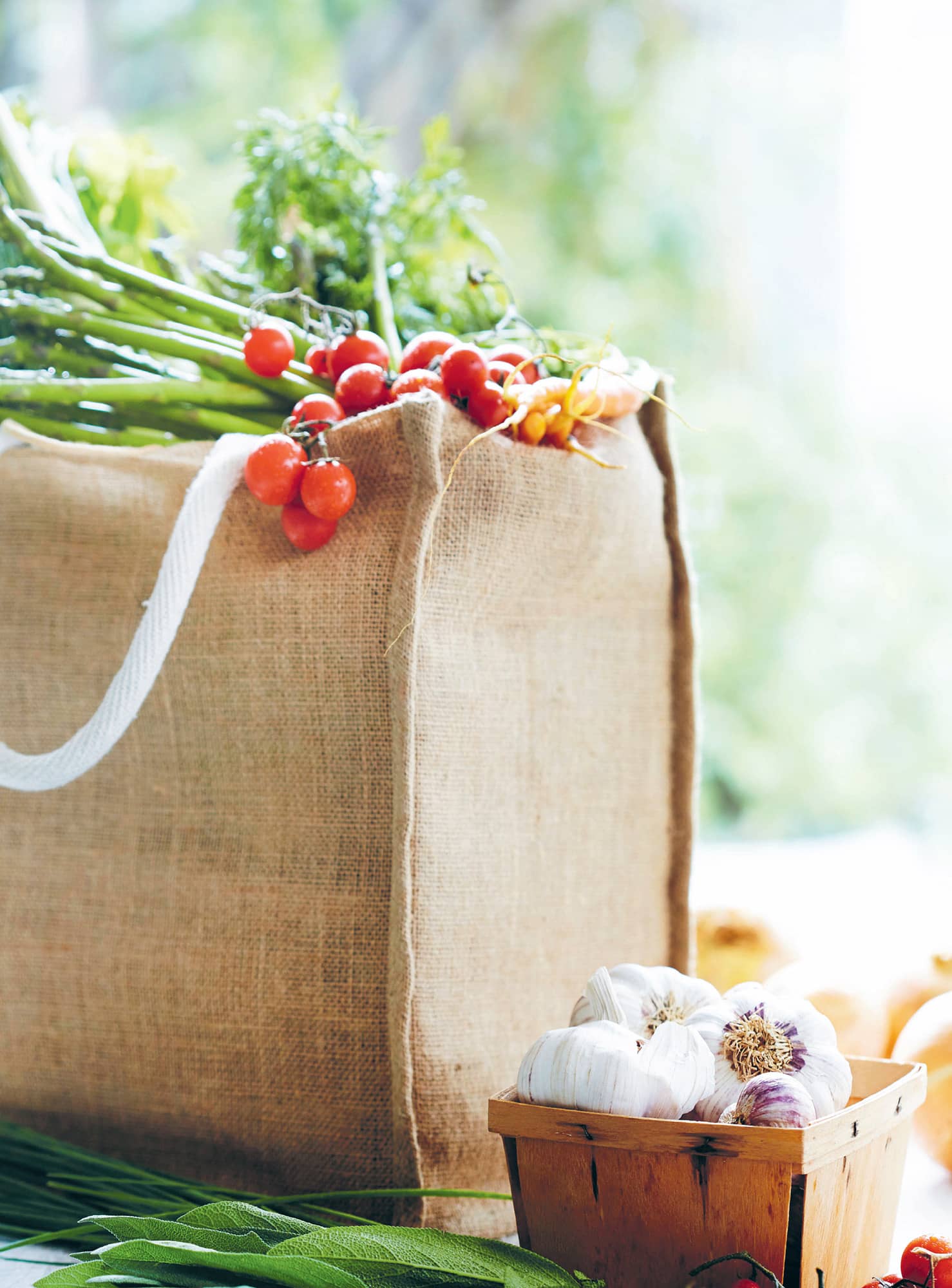
CURBING CRAVINGS
A new health protocol brings with it a wave of excitement for reaching your future destination of healing and vitality, but it’s really important to face the facts: an elemental diet won’t always be a walk in the park. Ask any entrepreneur, visionary or high-level leader about achieving their success, and they’ll always have a story of overcoming obstacles, opposition, doubts and failures. In making the decision to heal your gut, you too are in essence a leader – a leader of your own body and health.
Rather than succumbing to the health-opposing food culture around you, you’re taking a stand for your own health, and committing to do whatever it takes to heal your gut and improve your life and long-term wellbeing. If you can allow this thought to keep your mindset strong during the elemental phase, you’ll be one step ahead of people who go into a health protocol without an inner commitment.
One of the greatest obstacles you’ll face in the beginning will be “the battle of the appetite.” The shift from eating whatever your body craves to consuming only gut-healing and digestion-friendly foods will involve a sacrifice, and your body is likely to pull out the placards and protest.
Sip herbal tea. It’s one excellent option for alleviating those sugar cravings.
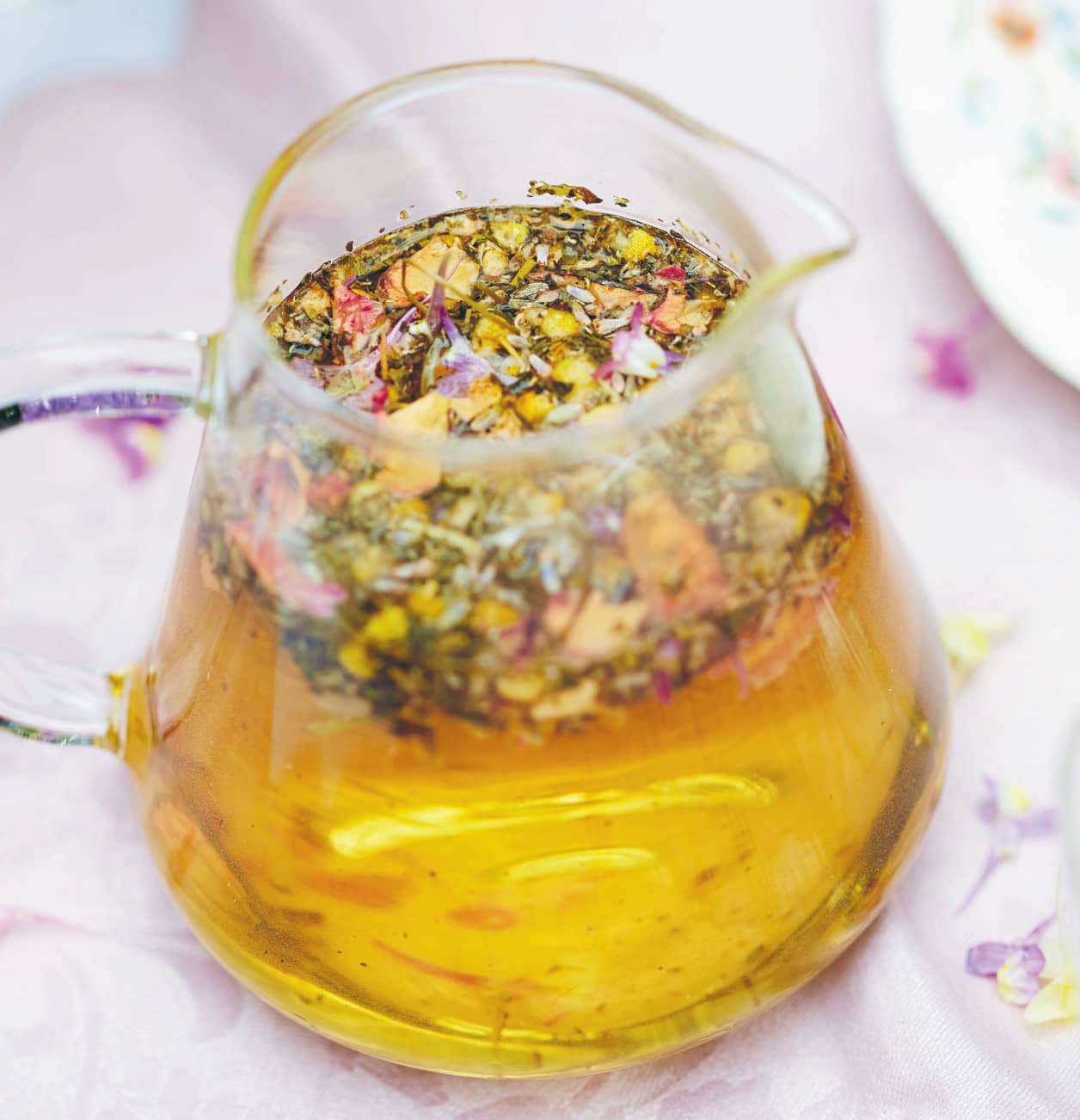
Watching your friends and family blissfully munching down a Sunday lunch and dessert while you’re slurping your healthy soups may arouse your appetite for other kinds of not-so-healthy-right-now foods. It’s important to tell yourself that you’re not the victim here, but rather that you’re a victor who’ll do whatever it takes to achieve healing and balanced health.
In moments like these, throughout the four-week protocol of phase one, you’re going to need some armor. Although the appetite may be hardwired, you can do a number of practical things to kick those food cravings to the kerb.
* SIP HERBAL TEA: Licorice root tea has an amazing super-sweet taste that fills you with every sip, making it excellent during sugar cravings. Passing the time with a Nutmeg, Saffron and Cashew Nightcap or a Curative Coffee will make you feel nourished without sabotaging your healing and treatment protocol.
* DO SOMETHING “SWEET” FOR YOURSELF: If you’re craving sugary foods, distract yourself by doing something that gives you that “sweet” feeling emotionally. Cuddle a loved one; take a long candlelit bath with Epsom salts (see here) and sweet-smelling essential oils; or, if you have a pet, snuggle up with them or take them out for a walk – anything that satisfies your craving emotionally rather than reaching for confectionery.
* DISTRACT YOURSELF: When the battle of the appetite rises, shift your mind to other things. Read one of your favorite books, get outside and go for a swim in the ocean (if you can) or take a nice walk in nature to get your endorphins pumping. Feeling a ray of sunshine on your skin will also improve your mood and help your cravings pass.
* EAT REVERSE GATEWAY FOODS: When “gateway foods” (foods that are particularly tempting) challenge you, fight back with a “reverse gateway food.” Craving hot chips? Try some Cheesy Mashed Cauliflower instead. Deeply desiring sweets? Blend raspberries with some coconut water and freeze for a sugar-free sorbet, or enjoy some sweet mashed carrot and sweet potato to counteract your craving. Try Savory Smashed Root Vegetables or some Scrambled Eggs.
* KEEP BUSY: Have you ever noticed that when you’re really busy, you don’t think about food as much? Pull out your calendar and fill it up with goals and tasks, particularly ones you’re passionate about and that make you feel inspired and engaged.
* EAT REGULARLY AND MINDFULLY: Cravings are less likely to occur if you have your meals regularly throughout the day. Be mindful of the goodness that’s filling your body and thankful that you’re now healing your gut. These positive thoughts will keep you focused and on track.
SUPERCHARGED TIP
Keep busy doing the things you love to do. Boredom is the ultimate appetite increasing agent.
MAINTENANCE ON THE FLY
It’s relatively easy to stay on the gut-healing protocol when you’re in the comfort of your own home, but real life can sometimes throw a wrench in the works. The demands of your work life, a busy family schedule, work-related travel and vacations can leave you with minimal control over what you put into your body. Rather than letting outside circumstances unravel all your efforts while healing your gut, here are a few strategies you can put in place for maintaining your healing on the fly.
MAKE A MEALPLAN
Following a meal plan makes life significantly less chaotic. By organizing your week’s worth of meals in advance you’ll never be left in a situation where you’re stuck for something to eat, and you’ll be much less likely to reach for a gut-sabotaging snack. All you need is an hour each week where you can sit down and design your meal plan and correlating shopping list with appropriate ingredients. There are even set meal planners you can use in this book if you don’t want to create your own. Remember, whatever phase of the gut-healing protocol you’re on, you can plan your meals ahead for the coming week. My favorite meal-planning days are Sundays, as they’re the most convenient for me, but perhaps for you it could be midweek or even a free weekend night.
FIX AND FREEZE YOUR MAKE-AHEADS
The beauty of my gut-healing recipes is that they’re fridge and freezer friendly, particularly the soups, stocks and smoothies, and they taste even better the next day. Once your meal planning and shopping are complete for the week ahead, it’s time to start creating your grab-and-go meals. I recommend cooking up large batches of recipes such as Fennel, Tomato and Roast Garlic Soup, Parsley and Leek Soup with Lemon or Pea, Spinach and Lamb Soup, and dividing these into single-serve portions so you can transport them to work easily. Try to use this day to have all your time-consuming meal preparations done: chopping, washing and cooking veggies and blending can all be done in advance. Then fill your freezer and fridge with your homemade convenience foods made your way.
SUPERCHARGED TIP
Take an avocado to work and make an instant mash with a drizzle of lemon or lime and some freshly cracked pepper. Add a couple of dashes of wheat-free tamari and apple cider vinegar. It’s my favorite in-a-pinch snack, full of appropriately healthy anti-inflammatory fats.
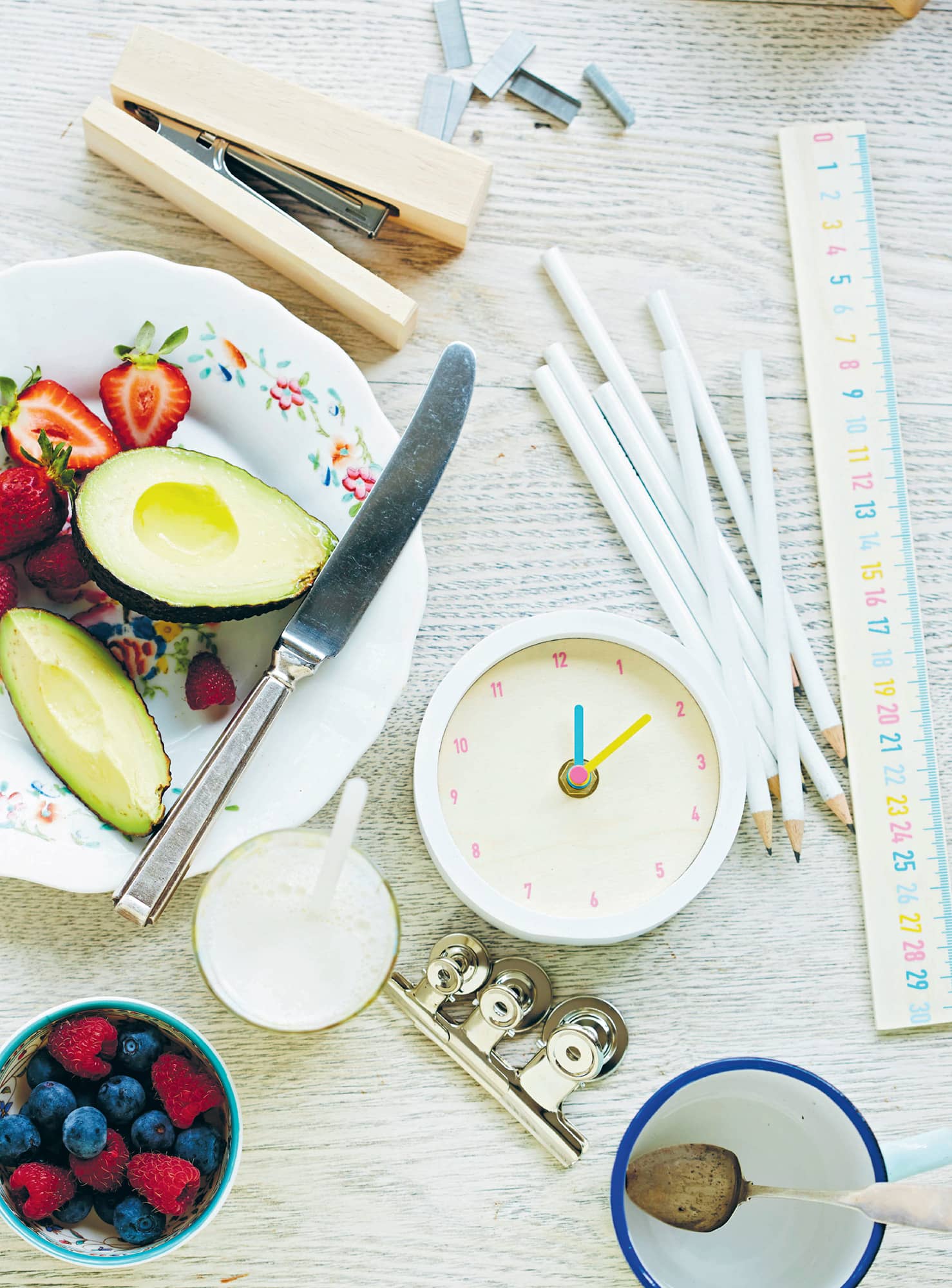
PREPARE GOOD FOOD FOR WHEN YOU’RE ON THE GO
Make up “dry mixes” and seal them in zip-lock bags. You can also prepare all of the dry ingredients included in the herbal tea mixtures, such as the Anti-inflammatory Toddy, Aromatic Curry Leaf Tisane and Dandy Chai Latte in advance and in bulk by using dried spices and powdered stevia. Take them to work in zip-lock bags, then just pour into a cup and add hot water. Dry mixes are also my secret weapon during flights. Strict airport laws unfortunately prevent the carrying of liquids, but you can carry a pre-made dry mix and ask for water on the plane, or find other liquid ingredients at your destination. Dry mixtures of my Supercharged Shake are also a terrific way to fuel yourself conveniently while on vacations, and give yourself a boost of nutrients. Zip-lock bags are useful because they mold to any shape and you can pop them in your carry-on luggage.
Invest in a thermos. A good stainless-steel spill-proof thermos can be easily filled with fiber-rich soups, hot drinks and mashes on the go. Insulated thermoses can keep food warm for up to seven hours. Choose a thermos with a wide mouth so that you can easily dig a spoon into it instead of using a bowl, to save on washing dishes. Or you could buy one with a cap that doubles as a bowl. Fold a tea towel and wrap it around the bottom of your thermos to help maintain the temperature. It also doubles as a napkin! Keeping a small plunger at work will allow you to enjoy your “dry mix” teas easily, sans tea bag.
Seek out old jars to use as wonderful, affordable, BPA- and chemical-free smoothie, salad, soup, and just-about-anything transporters. If you’re carrying it in your bag, wrap it in a scarf or tea towel to keep it secure and snug. If you’re looking for a foolproof and leak-proof solution, try canning jars. They’re rugged and durable and made from thicker glass, making them more jostle-proof! Mason jars with no-leak lids can be fitted and rugged up with a homemade washable cover to keep them insulated and avoid spillage. Containers with screw-top lids are also handy for packing liquids safely. Jars give food less of a leftover feel and more of a homemade impression. Bring your own cutlery for a waste-free meal.
The key to successful gut healing is to be organized, with convenient, ready-to-go meals in your gut-healing arsenal. Heat up soups on the stovetop wherever possible, as the microwave will kill nutrients and turn them into toxic compounds. You’re better off consuming soups at room temperature than from the microwave.
SUPERCHARGED TIP
Before adding hot soup to your thermos, pour in some warm water and swish it around, then pour it out. Add your piping hot soup and close the lid immediately. This will help keep your soup as warm as possible. Second law of thermodynamics!

STOCK UP YOUR WORKPLACE
If you have access to a fridge and kitchenette space at work, fill it with anything you know you’ll need. Stock up on almond and coconut milk for tea and supplement powders, any fresh raw ingredients such as avocados to mash and smash over soups, and berries to top off smoothies. Label and date these ingredients to ensure they’re clearly defined and won’t be thrown out or eaten by accident. Upgrade your midday meal by keeping a beautiful bowl, glass, mug and cutlery at work, and make me a pinky promise never to eat out of a plastic container again. Try to have lunch outside and avoid “lunch al desko” – your mind and body will both say thank you.
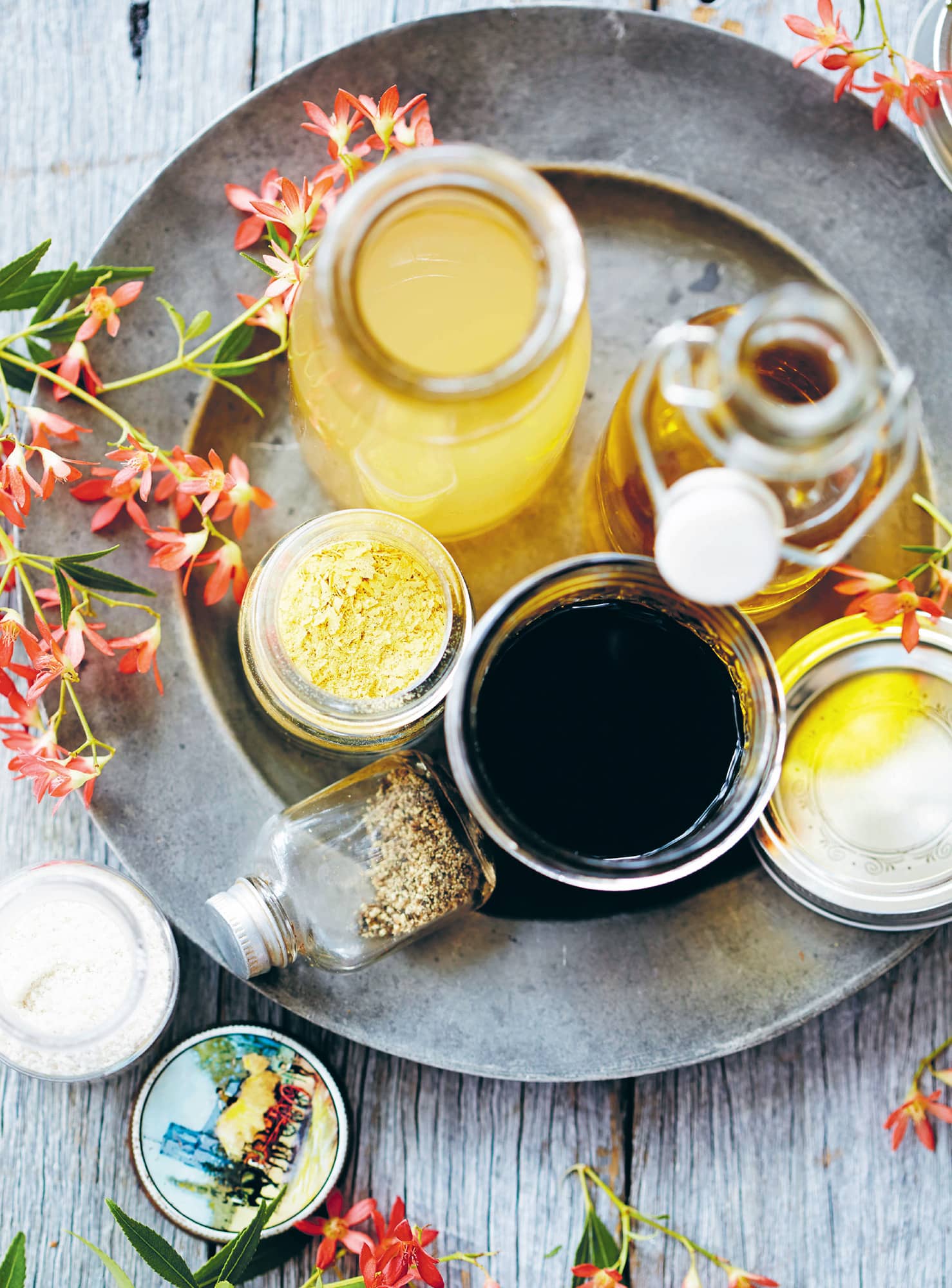

A TYPICAL HEALING DAY, PHASE ONE
This sample plan is an idea of a typical day on the Heal Your Gut program during phase one, so you can start to create your own healing map. Yours may look slightly different from this based on your particular symptoms.
EARLY MORNING: Enjoy a glass of hot water with lemon, Zested Ginger Beer or Morning Elixir.
BREAKFAST: Enjoy a healing juice or smoothie – try Lee’s Green Juice or a Purple Power Smoothie. If you’re craving a breakfast bowl, you can indulge in Creamy Buckwheat Porridge with Cashew Milk as an occasional breakfast option if you suffer no digestive discomfort afterward.
MORNING TEA: Enjoy a warming drink such as Turmeric Tea, Dandy Chai Latte or Curative Coffee.
LUNCH: Tuck into anti-inflammatory Thirty-clove Garlic and Onion Soup.
AFTERNOON TEA: A Berry Burst Smoothie will really fill you up and cleanse your insides while bringing you much-needed nutrients.
DINNER: Indulge in a delicious Superfood Soup or White Fish Soup with Saffron.
DESSERT: If craving something sweet, blend frozen berries with a little coconut water for a “berry sorbet,” or try my Raspberry Gelato or Berry Smoothie Bowl.
Throughout the day, be sure to drink plenty of filtered water, or water with lemon juice, or try an Electrolyte Balancer. If you’re craving solid food, the best foods are steamed vegetables; white fish, salmon or sardines; lightly scrambled eggs; or a small serving of brown rice. Nutritious dips and mashes are okay too.
Here are some more ideas to inspire your menu planning for phase one, the initial four-week period.
BREAKFAST: Try juices or smoothies made with avocado, cucumber, lemon, lime, spinach, kale, zucchini, broccoli, fennel, cilantro or parsley. Mix up the flavors!
SNACKS: Drink Soothing Sage, Mint and Ginger Tea, homemade bone broth (see here), homemade vegetable stock (see here), or green smoothies blended with coconut water or coconut milk. Avocados and a spoonful of coconut oil blended into a smoothie will make it creamy and filling. You can have a smash or mash bowl if you feel the need for a hearty snack (see “Easy-to-digest meals in a bowl”).
LUNCH OR DINNER: Enjoy Lemongrass Thai Soup, Lamb and Zucchini Soup, Karmic Korma or any other soup made from sauteed, steamed or roasted vegetables, combined with herbs, spices and Celtic or Himalayan sea salt. Blend with bone broth, vegetable stock or filtered water. For a creamier soup, add coconut milk. If you’re feeling fishy, chow down on Salmon Chowder or indulge in a fun Sardine Mash Pot.
CREATING YOUR OWN HEALING PLAN
Now that you have the information you need to start your four-week protocol, it’s time to look through the recipes and choose your favorites, then create your own healing plan.
Start by creating your own based on the information I’ve given you, or use the weekly planners on the following pages as a guide. These include my own personal planner plus a vegetarian version and a planner for busy people. I’ve also included a planner for daily restorative activities.
Once you’ve decided which recipes you’re going to incorporate into your four-week protocol, you can start to pull together your shopping list using the basic lists shown here.

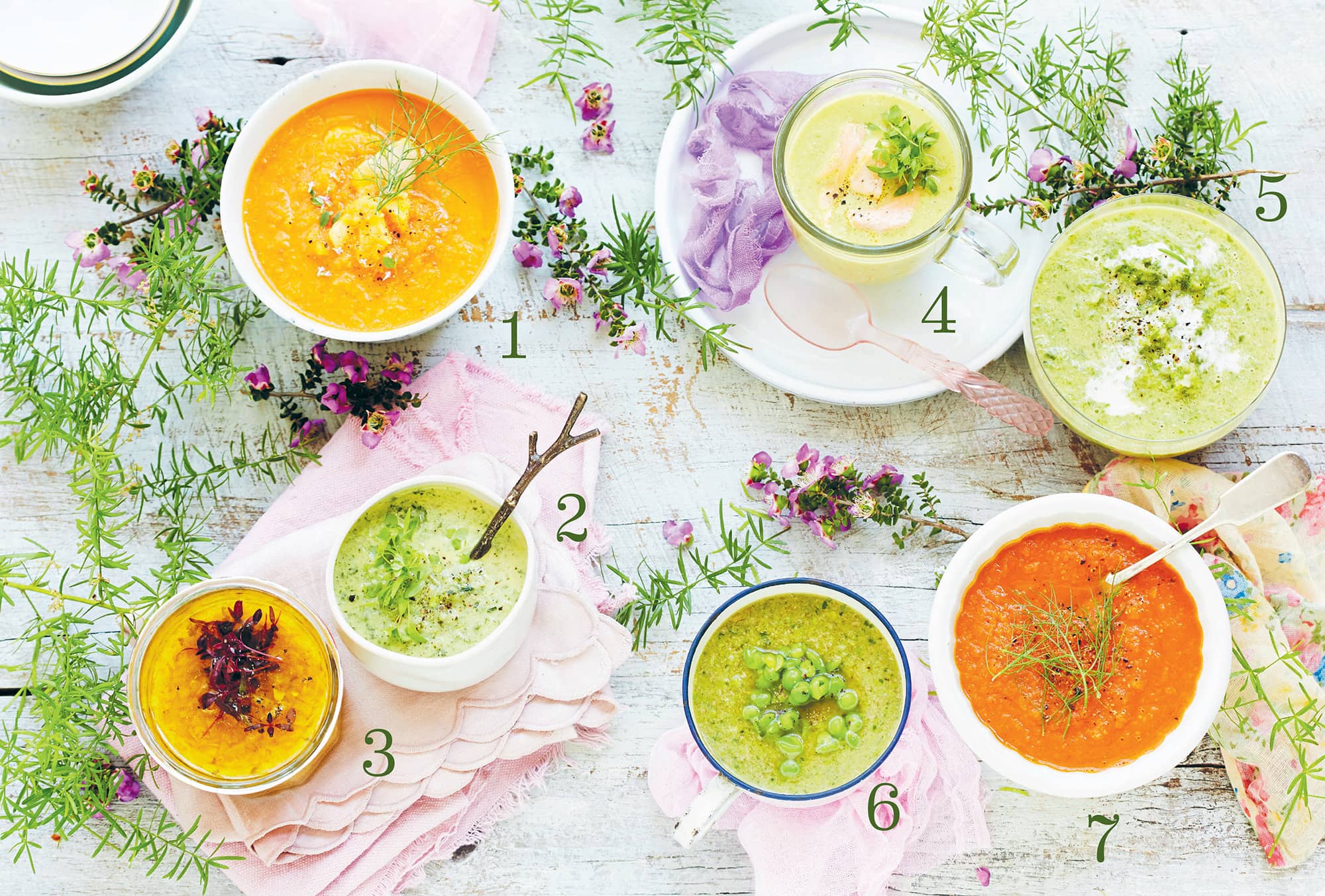
WEEKLY MEAL PLANNER WEEK 1
These plans are just a guide to show you the variety of recipes available. You might want to have the same meal a couple of days in a row if you’ve made extra quantities.
If you’re still hungry after a soup, try one of the “Easy-to-digest meals in a bowl”. It’s best to avoid starchy vegetables such as yams, potatoes, pumpkin (squash), sweet potato, parsnips and carrots in the first four weeks, but tuck into Savoury Smashed Root Vegetables if you feel like something sweet. It won’t delay your progress and it will help you overcome the craving.
AFTER RISING |
|
MONDAY |
|
TUESDAY |
|
WEDNESDAY |
|
THURSDAY |
|
FRIDAY |
|
SATURDAY |
|
SUNDAY |
|
BREAKFAST |
|
MONDAY |
|
TUESDAY |
|
WEDNESDAY |
|
THURSDAY |
|
FRIDAY |
|
SATURDAY |
|
SUNDAY |
|
MID-MORNING |
|
MONDAY |
|
TUESDAY |
|
WEDNESDAY |
|
THURSDAY |
|
FRIDAY |
|
SATURDAY |
|
SUNDAY |
|
LUNCH |
|
MONDAY |
|
TUESDAY |
|
WEDNESDAY |
|
THURSDAY |
|
FRIDAY |
|
SATURDAY |
|
SUNDAY |
|
DINNER |
|
MONDAY |
|
TUESDAY |
|
WEDNESDAY |
|
THURSDAY |
|
FRIDAY |
Cheesy Mashed Cauliflower + Mushy Peas + Cumin Digestive Aid |
SATURDAY |
|
SUNDAY |
|
DESSERT |
|
MONDAY |
|
TUESDAY |
|
WEDNESDAY |
|
THURSDAY |
|
FRIDAY |
|
SATURDAY |
Baked Blueberry Custards + Nutmeg, Saffron and Cashew Nightcap |
SUNDAY |
|
Berries are the fruit least likely to cause digestive problems and can be eaten in moderation. If they cause an increase in symptoms for you, avoid them altogether for four weeks then reintroduce them once your gut is healed and your symptoms have subsided.
If you’re following a low-FODMAP diet for food intolerances, replace the onion and garlic in recipes with the green part of a scallion, or with chives or asafoetida.
If coconut milk is a problem for you, use nut or seed milks instead.
NOTE: Numbers in brackets are page numbers for recipes. An asterisk (*) means optional.
WEEKLY MEAL PLANNER WEEK 2
AFTER RISING |
|
MONDAY |
|
TUESDAY |
|
WEDNESDAY |
Hot water with lemon and apple cider vinegar |
THURSDAY |
|
FRIDAY |
|
SATURDAY |
|
SUNDAY |
|
BREAKFAST |
|
MONDAY |
|
TUESDAY |
|
WEDNESDAY |
Scrambled Eggs with avocado |
THURSDAY |
|
FRIDAY |
|
SATURDAY |
|
SUNDAY |
|
MID-MORNING |
|
MONDAY |
|
TUESDAY |
|
WEDNESDAY |
|
THURSDAY |
|
FRIDAY |
|
SATURDAY |
|
SUNDAY |
|
LUNCH |
|
MONDAY |
|
TUESDAY |
|
WEDNESDAY |
|
THURSDAY |
|
FRIDAY |
|
SATURDAY |
|
SUNDAY |
|
DINNER |
|
MONDAY |
|
TUESDAY |
|
WEDNESDAY |
|
THURSDAY |
Garden-fresh Asparagus Soup + Green Bean, Tomato and Mint Mash |
FRIDAY |
|
SATURDAY |
|
SUNDAY |
|
DESSERT |
|
MONDAY |
|
TUESDAY |
|
WEDNESDAY |
|
THURSDAY |
|
FRIDAY |
|
SATURDAY |
|
SUNDAY |
Baked Blueberry Custards + Nutmeg, Saffron and Cashew Nightcap |
WEEKLY MEAL PLANNER WEEK 3
AFTER RISING |
|
MONDAY |
Hot water with lemon and apple cider vinegar |
TUESDAY |
Zested Ginger Beer or Homemade Kombucha with ginger |
WEDNESDAY |
|
THURSDAY |
|
FRIDAY |
|
SATURDAY |
Hot water with lemon and apple cider vinegar |
SUNDAY |
|
BREAKFAST |
|
MONDAY |
|
TUESDAY |
|
WEDNESDAY |
|
THURSDAY |
|
FRIDAY |
|
SATURDAY |
|
SUNDAY |
|
MID-MORNING |
|
MONDAY |
|
TUESDAY |
|
WEDNESDAY |
|
THURSDAY |
|
FRIDAY |
|
SATURDAY |
|
SUNDAY |
|
LUNCH |
|
MONDAY |
|
TUESDAY |
|
WEDNESDAY |
Fennel, Tomato and Roast Garlic Soup + Broccoli Mash + Cumin Digestive Aid |
THURSDAY |
|
FRIDAY |
Sweet Green Bean Soup + Cheesy Mashed Cauliflower + Mushy Peas |
SATURDAY |
|
SUNDAY |
|
DINNER |
|
MONDAY |
Iceberg Lettuce and Coconut Soup + Savory Smashed Root Vegetables |
TUESDAY |
|
WEDNESDAY |
Watercress, Leek and Coconut Soup + Minty Smashed Zucchini with Garlic |
THURSDAY |
Thirty-clove Garlic and Onion Soup or Karmic Korma + Kimchi* |
FRIDAY |
|
SATURDAY |
Comforting Cauli and Turnip Soup + Green Bean, Tomato and Mint Mash |
SUNDAY |
|
DESSERT |
|
MONDAY |
|
TUESDAY |
|
WEDNESDAY |
|
THURSDAY |
|
FRIDAY |
|
SATURDAY |
Baked Blueberry Custards + Nutmeg, Saffron and Cashew Nightcap |
SUNDAY |
|
WEEKLY MEAL PLANNER WEEK 4
AFTER RISING |
|
MONDAY |
Homemade Kombucha with ginger |
TUESDAY |
|
WEDNESDAY |
|
THURSDAY |
Hot water with lemon and apple cider vinegar |
FRIDAY |
|
SATURDAY |
|
SUNDAY |
Homemade Kombucha with ginger |
BREAKFAST |
|
MONDAY |
|
TUESDAY |
|
WEDNESDAY |
|
THURSDAY |
|
FRIDAY |
|
SATURDAY |
|
SUNDAY |
|
MID-MORNING |
|
MONDAY |
|
TUESDAY |
|
WEDNESDAY |
|
THURSDAY |
|
FRIDAY |
|
SATURDAY |
|
SUNDAY |
|
LUNCH |
|
MONDAY |
|
TUESDAY |
Super-quick Chicken Soup + Broccoli Mash + Easy-to-make Sauerkraut* |
WEDNESDAY |
|
THURSDAY |
|
FRIDAY |
Parsley and Leek Soup with Lemon + Cheesy Mashed Cauliflower + Mushy Peas + Cumin Digestive Aid |
SATURDAY |
|
SUNDAY |
|
DINNER |
|
MONDAY |
Lemongrass Thai Soup + Squashy Yellow Squash + Easy-to-make Sauerkraut* |
TUESDAY |
Iceberg Lettuce and Coconut Soup + Savory Smashed Root Vegetables |
WEDNESDAY |
|
THURSDAY |
|
FRIDAY |
|
SATURDAY |
White Fish Soup with Saffron + Green Bean, Tomato and Mint Mash |
SUNDAY |
|
DESSERT |
|
MONDAY |
|
TUESDAY |
|
WEDNESDAY |
Baked Blueberry Custards + Nutmeg, Saffron and Cashew Nightcap |
THURSDAY |
|
FRIDAY |
|
SATURDAY |
Raspberry and Lime Pudding + Nutmeg, Saffron and Cashew Nightcap |
SUNDAY |
|
VEGETARIAN WEEKLY MEAL PLANNER
To increase your protein intake during the elemental diet, try these options:
* Add 1/4 cup (1 3/4 oz/50 g) quinoa to soups, for adequate protein (1/4 oz per cup/8 g) and nine essential amino acids.
* Choose protein-rich vegetables, such as green peas (1/4 oz protein per cup/7.9 g), broccoli (1/4 oz per cup/8 g), artichokes (1/8 oz per cup/6 g) and leafy greens.
* Add spirulina powder to smoothies. Spirulina is one of the best-known protein sources (70 percent complete protein versus cooked steak at 25 percent).
* Use nut milk in smoothies: almond, cashew and pistachio milk are highest in protein.
* If your tummy can handle them, add a sprinkle of chia seeds to desserts for 1/8 oz/5 g protein per 2 tablespoons.
* Add hemp powder (1/4 oz protein/10 g per 1/4 cup) to smoothies.
* Make the Chocolaty Mousse. Cacao does contain caffeine, so eat it only in moderation while healing your gut, and earlier in the day is best.
* If you’re not vegan, try sprinkling bee pollen on top of smoothies, porridge or desserts for a healthy protein boost.
* If you can tolerate them without candida symptoms, after the first couple of weeks, add high-protein lentils, chickpeas, white beans or pinto beans to soups with 1/4 cup (1 3/4 oz/50 g) quinoa. Soak them overnight and rinse them well so they’re easier to digest. Adding kombu to the cooking water makes them easier on the tummy and makes their nutrients more bioavailable.
* Add nutritional yeast.
AFTER RISING |
|
MONDAY |
|
TUESDAY |
|
WEDNESDAY |
|
THURSDAY |
|
FRIDAY |
Hot water with lemon and apple cider vinegar |
SATURDAY |
|
SUNDAY |
|
BREAKFAST |
|
MONDAY |
|
TUESDAY |
|
WEDNESDAY |
|
THURSDAY |
|
FRIDAY |
|
SATURDAY |
|
SUNDAY |
|
MID-MORNING |
|
MONDAY |
|
TUESDAY |
|
WEDNESDAY |
|
THURSDAY |
|
FRIDAY |
|
SATURDAY |
|
SUNDAY |
|
LUNCH |
|
MONDAY |
|
TUESDAY |
|
WEDNESDAY |
|
THURSDAY |
|
FRIDAY |
|
SATURDAY |
|
SUNDAY |
|
DINNER |
|
MONDAY |
|
TUESDAY |
|
WEDNESDAY |
|
THURSDAY |
|
FRIDAY |
Fennel, Tomato and Roast Garlic Soup + Cheesy Mashed Cauliflower |
SATURDAY |
Lemongrass Thai Soup + Squashy Yellow Squash + Ratatouille Bowl |
SUNDAY |
Broccolini, Kale and Mint Soup + Green Bean, Tomato and Mint Mash |
DESSERT |
|
MONDAY |
|
TUESDAY |
|
WEDNESDAY |
|
THURSDAY |
|
FRIDAY |
|
SATURDAY |
|
SUNDAY |
|
WEEKLY MEAL PLANNER FOR BUSY PEOPLE
AFTER RISING |
|
MONDAY |
Hot water with lemon and apple cider vinegar |
TUESDAY |
|
WEDNESDAY |
|
THURSDAY |
Hot water with lemon and apple cider vinegar |
FRIDAY |
|
SATURDAY |
Hot water with lemon and apple cider vinegar |
SUNDAY |
|
BREAKFAST |
|
MONDAY |
|
TUESDAY |
|
WEDNESDAY |
|
THURSDAY |
|
FRIDAY |
|
SATURDAY |
|
SUNDAY |
|
MID-MORNING |
|
MONDAY |
|
TUESDAY |
|
WEDNESDAY |
|
THURSDAY |
|
FRIDAY |
|
SATURDAY |
|
SUNDAY |
|
LUNCH |
|
MONDAY |
|
TUESDAY |
|
WEDNESDAY |
|
THURSDAY |
White Fish Soup with Saffron + Green Bean, Tomato and Mint Mash |
FRIDAY |
|
SATURDAY |
|
SUNDAY |
|
DINNER |
|
MONDAY |
|
TUESDAY |
|
WEDNESDAY |
|
THURSDAY |
|
FRIDAY |
|
SATURDAY |
|
SUNDAY |
|
DESSERT |
|
MONDAY |
|
TUESDAY |
|
WEDNESDAY |
|
THURSDAY |
|
FRIDAY |
|
SATURDAY |
|
SUNDAY |
|
DAILY RESTORATIVE ACTIVITIES PLANNER
SPIRITUAL PRACTICE AND MEDITATION |
|
WEEKDAYS |
Spend 10 minutes breathing into your belly (deeply, from your diaphragm) each morning before work |
WEEKENDS |
Spend 10 minutes breathing into your belly (deeply, from your diaphragm) each morning |
EXERCISE AND MOVEMENT |
|
WEEKDAYS |
Take a 10-minute walk around the block at lunchtime every other day |
WEEKENDS |
Do some gentle stretching each day |
SLEEP |
|
WEEKDAYS |
Go to bed before 10 pm each day Have an Epsom salts bath (see here) before bed and do some guided meditation before sleep every other day |
WEEKENDS |
|

